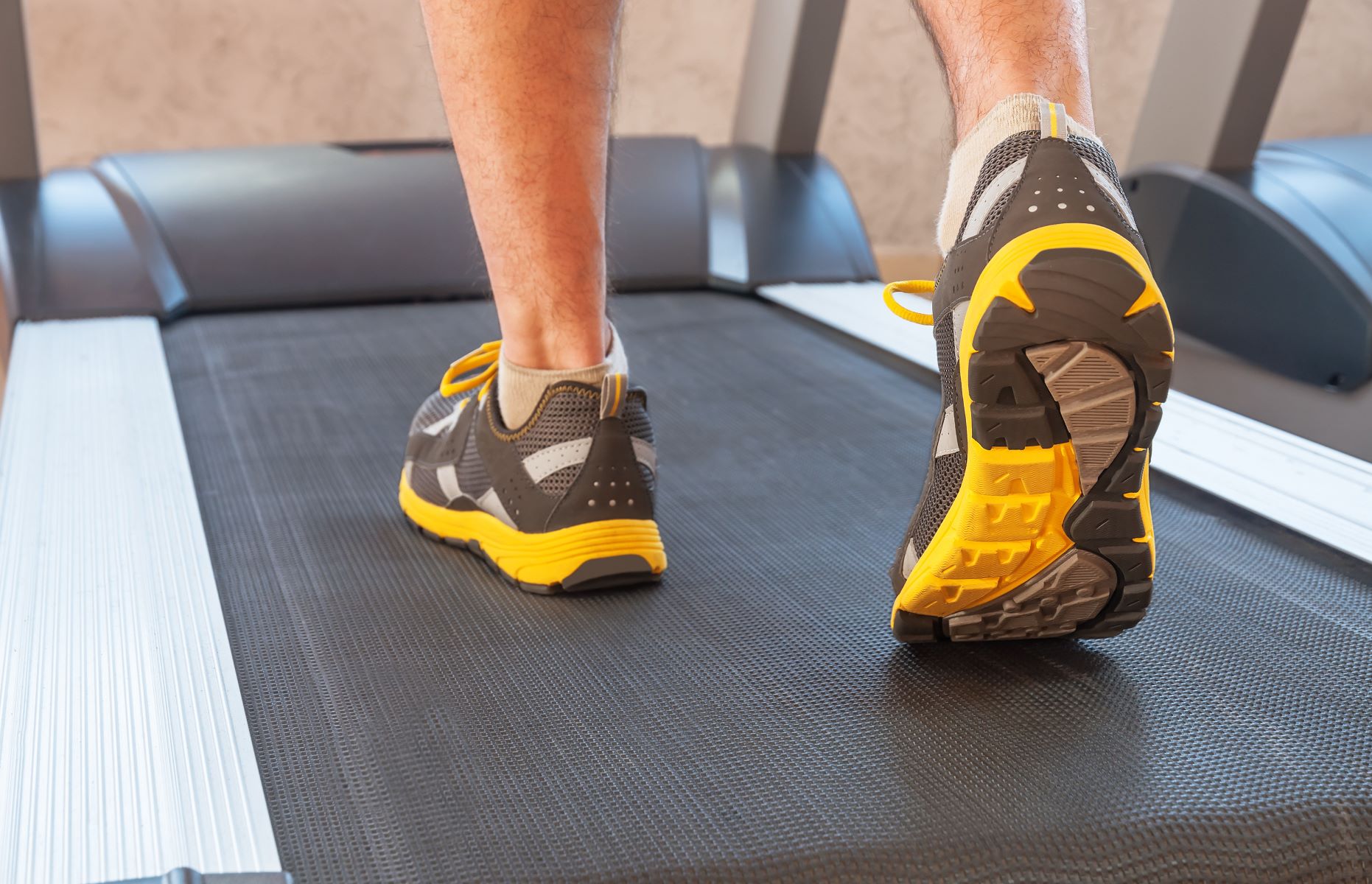

Featured
Why Muscles Hurt After Workout
Modified: March 1, 2024
Learn why your muscles hurt after a workout and discover featured tips to alleviate post-exercise discomfort.
Introduction
Have you ever experienced that satisfying burn in your muscles after a challenging workout? While it may be a sign of your hard work paying off, that post-workout muscle soreness can leave you feeling a bit achy and wondering why your muscles hurt. Understanding the causes behind this discomfort can help you better care for your body and optimize your fitness routine.
Muscle soreness, also known as delayed onset muscle soreness (DOMS), is a common phenomenon that occurs after engaging in strenuous physical activity or trying a new exercise. It typically manifests as pain, stiffness, and tenderness in the muscles that were involved in the workout.
In this article, we will delve into the various factors that contribute to post-workout muscle pain and explore strategies to alleviate them. From the role of lactic acid and inflammation to the importance of proper warm-up, stretching, nutrition, and rest, we will cover everything you need to know to understand and manage muscle soreness.
While muscle soreness is a normal part of the fitness journey, understanding its causes and taking proactive steps to manage it can significantly enhance your overall workout experience and subsequent recovery. So, let’s dive in and uncover the secrets behind why your muscles hurt after a workout, and how you can mitigate that discomfort for a more enjoyable and effective training regimen.
Understanding Muscle Soreness
Muscle soreness is a natural response to physical activity, especially when it involves intense or unfamiliar movements. It is important to understand that not all types of muscle soreness are the same. The soreness experienced immediately after a workout versus the delayed onset muscle soreness (DOMS) that develops hours or days later have different underlying causes.
Immediate muscle soreness is often caused by the build-up of lactic acid, a byproduct of the energy production process that occurs in our muscles. When we engage in intense exercise, our muscles require more energy, and this increased demand can lead to the production of lactic acid. Lactic acid can contribute to a burning sensation and fatigue in the muscles during and right after a workout.
On the other hand, DOMS, which usually peaks 24 to 72 hours after exercise, is believed to be primarily caused by microscopic damage to muscle fibers. During an intense workout, especially one that involves eccentric muscle contractions (when the muscle lengthens while under tension), such as lowering a weight or descending a flight of stairs, the muscle fibers can experience tiny tears or trauma.
This damage triggers an inflammatory response in the body, resulting in pain, stiffness, and swelling. The process of repairing and rebuilding the damaged muscles during the recovery period is what ultimately leads to muscle growth and strength gains over time.
Understanding these different aspects of muscle soreness can help us better navigate our fitness routines. While immediate muscle soreness is generally temporary and subsides within a short period, DOMS can last for several days. It is essential to differentiate between the two and adjust our workout intensity accordingly to prevent excessive strain and potential injury.
Now that we have a basic understanding of muscle soreness, let’s explore the various factors that can contribute to post-workout muscle pain in more detail, so you can better prepare and alleviate discomfort in your fitness journey.
Causes of Post-Workout Muscle Pain
Post-workout muscle pain can be attributed to several factors, including lactic acid build-up, inflammation, and muscle damage. Let’s take a closer look at each of these causes:
Lactic Acid Build-up: During intense exercise, our muscles require a higher amount of energy. This increased demand can lead to the production of lactic acid as a byproduct of the energy production process. Lactic acid can create a burning sensation and contribute to muscle fatigue during and immediately after a workout. However, it is important to note that lactic acid is typically cleared from the muscles relatively quickly, and its presence alone is not the primary cause of delayed-onset muscle soreness (DOMS).
Inflammation: Intense exercise, especially eccentric muscle contractions, can cause microscopic damage to the muscle fibers. This damage triggers an inflammatory response in the body, resulting in pain, stiffness, and swelling. The inflammation process is a natural part of the body’s healing response, and it plays a vital role in repairing and rebuilding the damaged muscle fibers. However, excessive inflammation can contribute to prolonged muscle soreness.
Muscle Damage: The microscopic tears or trauma to the muscle fibers during a workout are a common cause of post-workout muscle pain. This muscle damage is more likely to occur during eccentric movements, when the muscle lengthens while under tension. These eccentric contractions can be found in exercises like lowering a weight or descending stairs. The body’s process of repairing and rebuilding the damaged muscles during the recovery period is what ultimately leads to muscle growth and improved strength over time.
While these factors contribute to muscle soreness, it is important to note that the intensity and duration of exercise can also impact the level of post-workout muscle pain experienced. Engaging in high-intensity workouts, increasing the overall training volume, or trying new exercises can all potentially lead to more significant muscle soreness.
By understanding the causes behind post-workout muscle pain, we can take proactive measures to help alleviate discomfort and facilitate faster recovery. In the following sections, we will explore strategies that can be implemented to mitigate muscle soreness and enhance our overall fitness journey.
The Role of Lactic Acid
Lactic acid often gets a bad rap when it comes to post-workout muscle pain, but its role in muscle soreness is often misunderstood. Contrary to popular belief, lactic acid is not the primary cause of the delayed onset muscle soreness (DOMS) experienced hours or days after a workout.
Lactic acid is produced as a byproduct of the energy production process that occurs in our muscles, particularly during intense exercise when our muscles require a higher amount of energy. As the body breaks down glucose to generate energy, lactic acid is produced.
During exercise, lactic acid can accumulate in the muscles, leading to a burning sensation and fatigue. This is often referred to as “muscular acidosis.” However, it is important to note that lactic acid is relatively quickly cleared from the muscles, usually within an hour of completing exercise.
Research has shown that the build-up of lactic acid is not directly responsible for the prolonged muscle soreness experienced in the days following exercise. Instead, it is considered a temporary side effect of intense physical activity.
So, if lactic acid is not the main cause of DOMS, what does contribute to the muscle soreness experienced after a challenging workout? The answer lies in the microscopic damage to the muscle fibers, inflammation, and the subsequent repair and rebuilding process that occurs during the recovery period.
Despite its temporary effects, lactic acid serves an important role during exercise. It is used as an additional fuel source by certain types of muscle fibers, allowing for continued muscular contraction when our primary energy stores are depleted.
It’s worth noting that lactic acid production and its effects can vary among individuals. Some people may have a higher tolerance to lactic acid build-up, while others may experience more pronounced sensations of muscular acidosis during intense exercise.
It’s important to listen to your body and gauge your personal tolerance during workouts. If you find that lactic acid build-up is affecting your performance or causing excessive discomfort, adjusting your intensity, incorporating strategic rest periods, and practicing proper breathing techniques can help manage these sensations.
While lactic acid may contribute to the temporary burn and fatigue during exercise, it is not the primary cause of DOMS. Understanding the role of lactic acid can help dispel misconceptions and allow us to focus on other factors that play a more significant role in post-workout muscle soreness.
Inflammation and Muscle Damage
Inflammation and muscle damage play crucial roles in post-workout muscle soreness. When we engage in intense exercise, especially movements involving eccentric contractions, our muscles experience microscopic damage to the muscle fibers. This damage triggers an inflammatory response in the body.
Inflammation is a natural protective response that occurs as the body’s way of repairing and rebuilding the damaged muscles. It involves the release of various chemicals and immune cells to the affected area, promoting healing and removing waste products.
During the inflammatory process, pain receptors are stimulated, leading to the sensation of muscle soreness and discomfort. This inflammation can cause swelling, stiffness, and tenderness in the muscles, making movements uncomfortable or limited.
The degree of inflammation and subsequent muscle soreness can vary depending on factors such as exercise intensity, duration, and individual susceptibility. In some cases, excessive inflammation can prolong the recovery period and delay muscle repair.
The body’s ability to manage inflammation and repair muscle damage effectively is influenced by various factors, including nutrition, hydration, and rest. Providing the body with adequate nutrients and staying hydrated can support the healing process by supplying the necessary building blocks for muscle repair.
Additionally, allowing sufficient rest and recovery time is crucial. During this period, the body repairs and rebuilds the damaged muscle fibers, leading to adaptations and improvements in strength and performance.
Strategies such as ice baths, compression garments, and non-steroidal anti-inflammatory drugs (NSAIDs) are sometimes used to alleviate inflammation and muscle soreness. However, it is important to note that these methods should be used judiciously and under the guidance of a healthcare professional, as excessive use of anti-inflammatory medications may impede the natural healing process.
Inflammation and muscle damage are part of the natural response to exercise and are essential for muscle adaptation and growth. While they contribute to temporary muscle soreness, taking steps to manage inflammation through proper nutrition, hydration, and rest can help minimize discomfort and facilitate faster recovery.
By understanding the role of inflammation and muscle damage in post-workout muscle soreness, we can strive to strike a balance in our training routines, allowing for adequate stimulus for muscle growth while also prioritizing recovery for optimal performance.
Delayed Onset Muscle Soreness (DOMS)
Delayed onset muscle soreness (DOMS) is a common phenomenon that many people experience after engaging in strenuous exercise or trying new activities. Unlike immediate muscle soreness, which is felt during or immediately after a workout, DOMS typically peaks 24 to 72 hours after exercise.
DOMS is characterized by muscle pain, stiffness, tenderness, and reduced range of motion. It can occur when we perform exercises that our muscles are not accustomed to, increase the intensity or duration of our workouts, or engage in activities that involve eccentric muscle contractions.
Eccentric contractions are movements where the muscle lengthens while under tension. Examples include lowering weights, descending stairs, or running downhill. These types of contractions are known to cause more muscle damage than concentric contractions (where the muscle shortens during contraction), contributing to the development of DOMS.
The exact mechanisms of DOMS are not fully understood, but it is believed to be the result of a combination of factors. The microscopic damage to muscle fibers during eccentric contractions stimulates an inflammatory response, leading to pain and swelling.
In addition to the inflammatory response, other factors, such as nerve sensitivity, changes in muscle metabolism, and an increase in free radicals, may also contribute to DOMS. These factors can cause sensitization of pain receptors and impair the muscle’s ability to contract and relax efficiently.
It’s important to recognize that DOMS is a normal response to intense physical activity and is not an indicator of a serious injury. However, severe or prolonged muscle soreness that limits normal daily activities or causes severe pain should be evaluated by a healthcare professional.
While there is no foolproof way to completely prevent DOMS, there are strategies that can help alleviate discomfort and promote faster recovery. These include:
Gradual Progression: Gradually increasing the intensity, duration, or frequency of your workouts can give your muscles time to adapt and minimize the severity of DOMS.
Active Recovery: Engaging in low-intensity exercises or activities that promote blood flow to the muscles, such as light cardio or gentle stretching, can help reduce muscle soreness and aid in recovery.
Hydration and Nutrition: Proper hydration and a balanced diet, rich in protein and nutrients, are important for muscle repair and recovery.
Massage and Foam Rolling: Techniques like massage and foam rolling can help reduce muscle tension, improve circulation, and alleviate muscle soreness.
Rest and Sleep: Giving your muscles adequate time to rest and recover is essential for reducing DOMS and optimizing performance in subsequent workouts.
By implementing these strategies, you can minimize the impact of DOMS on your training and enhance your ability to consistently engage in challenging workouts.
Strategies to Alleviate Muscle Soreness
While muscle soreness is a natural part of the fitness journey, there are various strategies you can implement to alleviate discomfort and promote faster recovery. Here are some effective strategies to help you manage and minimize muscle soreness:
Proper Warm-up and Cool Down: Before starting your workout, it is essential to prepare your muscles for the upcoming activity. A dynamic warm-up routine helps increase blood flow, raise body temperature, and loosen up the muscles, reducing the risk of injury and potential muscle soreness. Similarly, incorporating a cool-down with static stretching can aid in flushing out waste products and promote muscle relaxation.
Stretching and Foam Rolling: Stretching and using a foam roller can help relieve muscle tension and increase flexibility. By incorporating stretches for the major muscle groups, you can promote blood circulation and reduce muscle soreness. Foam rolling, or self-myofascial release, can further target specific areas of tightness and trigger points, improving muscle function and reducing post-workout pain.
Nutrition and Hydration: Proper nutrition is important for muscle recovery and reducing muscle soreness. Consuming an adequate amount of protein helps repair and rebuild damaged muscle fibers, while carbohydrates provide energy for the recovery process. Hydration is also crucial, as it supports nutrient delivery to the muscles and helps flush out waste products. Be sure to maintain a well-balanced diet and drink plenty of water before, during, and after your workouts.
Rest and Recovery: Allowing sufficient rest and recovery time is essential in preventing excessive muscle soreness and promoting optimal performance. Giving your muscles time to repair and rebuild is crucial for growth and improvement. Incorporating rest days into your training schedule and getting enough sleep each night can significantly contribute to your overall recovery.
Gradual Progression: Gradually increasing the intensity, duration, or frequency of your workouts can help your muscles adapt and minimize the severity of muscle soreness. Avoid sudden spikes in training load, as this can lead to excessive muscle damage and prolonged soreness. Listen to your body and adjust your workouts accordingly.
Ice and Heat Therapy: Applying ice packs or cold therapy can help reduce inflammation and numb the pain in sore muscles. Heat therapy, such as warm baths or heating pads, can promote blood flow and provide relief to tight muscles. Alternate between the two techniques or use whichever feels more comfortable for you.
Recovery Techniques: Various recovery techniques, such as massage, compression garments, and contrast showers (alternating between hot and cold water), can help improve blood circulation, reduce muscle tension, and alleviate soreness. Experiment with different techniques and find what works best for your body.
By incorporating these strategies into your fitness routine, you can effectively manage and alleviate muscle soreness. Remember that everyone’s body responds differently, so it might take some trial and error to find the combination of strategies that work best for you. By prioritizing recovery alongside your training, you can optimize your performance and make the most of your fitness journey.
Proper Warm-up and Cool Down
One of the most effective strategies to prepare your body for a workout and alleviate muscle soreness is to incorporate a proper warm-up and cool down routine. These essential components of a workout help optimize performance, reduce the risk of injury, and promote faster recovery. Here’s why warm-up and cool down are important:
Warm-up: A warm-up session is crucial before any physical activity. It gradually raises the heart rate, increases blood flow, and warms up the muscles, preparing them for the upcoming demands of the workout. It also helps to gradually increase range of motion, improve joint lubrication, and stimulate the nervous system. A good warm-up routine may include light cardio exercises like jogging or cycling, dynamic stretches that mimic the movements of the upcoming workout, and specific activation exercises for the targeted muscles.
Engaging in a proper warm-up routine offers several benefits:
Enhanced Performance: A thorough warm-up primes your body for the workout, improving both endurance and strength. Increased blood flow to the working muscles allows for better oxygen and nutrient delivery, resulting in improved performance and enhanced muscular function.
Injury Prevention: Warming up increases muscle elasticity, reducing the risk of strains, sprains, and other injuries. It also improves neuromuscular coordination, allowing for better control and stability during exercises. By gradually increasing the intensity of the warm-up, you prepare your body for the stress it will encounter during the workout.
Increased Flexibility: Proper warm-up can significantly improve flexibility and range of motion. By incorporating dynamic stretching exercises, you actively stretch and mobilize major muscle groups and joints, promoting better overall flexibility and reducing the likelihood of muscle imbalances.
Cool Down: The cool-down phase is often overlooked but is equally important as the warm-up. It involves gradually reducing the intensity of exercise and allowing your body to slow down. A cool-down routine typically includes light aerobic activity and static stretching exercises that target the major muscle groups. The purpose of the cool-down is to gradually return your heart rate and breathing to normal, prevent blood pooling in the extremities, and facilitate the removal of waste products from the muscles.
Benefits of a proper cool-down include:
Improved Recovery: A well-executed cool-down helps to clear metabolic waste products, such as lactic acid, from the muscles. By promoting blood circulation and lymphatic drainage, it aids in the delivery of oxygen and nutrients to the muscles, enhancing the recovery process and reducing muscle soreness.
Flexibility Maintenance: Static stretching during the cool-down helps to maintain and improve flexibility. Holding stretches for an extended period when the muscles are warm can gradually lengthen the muscles, improve joint range of motion, and prevent muscle tightness and imbalances.
Promotion of Relaxation: Cool-down exercises also have a psychological benefit, promoting relaxation and helping to transition from the intense workout to a restful state. It allows time for the body and mind to recover, helping to reduce stress levels and promote overall well-being.
Incorporating a proper warm-up and cool down into your workout routine is essential for optimal performance and minimizing muscle soreness. By taking the time to prepare your body for exercise and allowing it to recover properly, you can maximize the benefits of your workouts and enjoy a more enjoyable and effective fitness journey.
Stretching and Foam Rolling
Stretching and foam rolling are important techniques that can help alleviate muscle soreness and improve flexibility. They are commonly used before and after workouts to optimize muscle function, enhance performance, and aid in recovery. Let’s explore the benefits and best practices for stretching and foam rolling:
Stretching: Stretching exercises involve lengthening and elongating muscles to improve range of motion and flexibility. There are two main types of stretching: static stretching and dynamic stretching.
Static Stretching: Static stretching involves holding a stretch for a sustained period, typically for 15 to 30 seconds. This type of stretching is best done after a workout or physical activity, when the muscles are warm. It helps target specific muscles, elongating them and improving their flexibility over time.
Dynamic Stretching: Dynamic stretching involves moving through a full range of motion in a controlled manner. It often incorporates movements that mimic the exercises or activities to follow. Dynamic stretching is commonly used as part of a warm-up routine to increase blood flow to the muscles, activate the nervous system, and improve flexibility and joint mobility.
Benefits of stretching include:
Improved Flexibility: Regular stretching helps improve flexibility, allowing for better range of motion in joints and muscles. This can improve overall athletic performance, reduce the risk of injury, and enhance functional movement in daily activities.
Reduced Muscle Soreness: Stretching after a workout can help reduce muscle soreness and promote faster recovery. It increases blood flow to the muscles, facilitating the removal of waste products and reducing muscle tension and tightness.
Relaxation and Stress Relief: Stretching not only enhances physical well-being but also offers mental relaxation and stress relief. It provides an opportunity to focus on your body, breathe deeply, and release tension, improving overall mental and emotional well-being.
Foam Rolling: Foam rolling, also known as self-myofascial release, is a technique that involves using a foam roller to apply pressure to specific muscles and trigger points. The pressure helps release tension, break up adhesions within the muscle tissue, and improve circulation.
Benefits of foam rolling include:
Increased Flexibility and Range of Motion: Foam rolling targets knots and tight areas in the muscles, releasing tension and increasing suppleness. It can help improve muscle flexibility, joint range of motion, and overall mobility.
Reduced Muscle Soreness: Foam rolling helps alleviate muscle soreness by promoting blood flow and reducing muscle tightness. It can be used both before and after workouts to warm up muscles or aid in recovery.
Enhanced Muscle Recovery: Foam rolling activates the body’s natural healing mechanisms, promoting tissue repair and reducing inflammation. By breaking up scar tissue and adhesions, it can expedite muscle recovery and reduce the risk of injury.
Improved Performance: Regular foam rolling can improve overall performance by enhancing muscle activation and reducing muscular imbalances. By addressing tight or overactive muscles, it helps restore proper movement patterns, increasing efficiency and reducing the risk of compensation-related injuries.
When incorporating stretching and foam rolling into your routine, it’s important to listen to your body and avoid overstretching or applying excessive pressure. Perform stretches and foam rolling exercises mindfully and gradually, focusing on areas of tightness or discomfort. Consult with a fitness professional to learn proper techniques and identify specific stretches and foam rolling exercises that suit your individual needs.
Nutrition and Hydration
Nutrition and hydration are essential elements for managing and alleviating muscle soreness. Proper fueling before, during, and after workouts can support the recovery process, promote muscle repair, and reduce the severity of post-workout muscle pain. Here’s how nutrition and hydration play a key role:
Pre-Workout Nutrition: Consuming a balanced, nutrient-dense meal or snack before a workout provides the energy and nutrients needed for optimal performance and recovery. Aim for a combination of carbohydrates, protein, and healthy fats to provide sustained energy and enhance muscle protein synthesis.
Carbohydrates are the body’s primary source of fuel and can help sustain energy levels throughout your workout. Opt for complex carbohydrates like whole grains, fruits, and vegetables, as they provide a steady release of glucose into the bloodstream. Protein is important for muscle repair and growth. Include lean sources of protein such as poultry, fish, tofu, or legumes in your pre-workout meal. Healthy fats from sources like avocados, nuts, or olive oil can help support joint health and provide additional energy.
Hydration: Staying hydrated is crucial for overall performance and recovery. Dehydration can impair muscle function, increase fatigue, and hinder the body’s ability to repair and recover effectively. It’s important to drink water before, during, and after workouts to maintain proper hydration levels.
The exact amount of water needed varies depending on factors such as body weight, activity level, and environmental conditions. As a general guideline, aim to drink at least 8-10 cups (64 to 80 ounces) of water per day, and increase intake if you are engaging in intense physical activity or sweating excessively.
Post-Workout Nutrition: The post-workout period is a critical time to replenish nutrients and support muscle recovery. Consuming a combination of carbohydrates and protein within 30 minutes to an hour post-workout can help replenish glycogen stores, repair muscle tissue, and reduce muscle soreness.
Opt for easily digestible, high-quality protein sources such as whey protein, Greek yogurt, or plant-based options like tofu or legumes. Pair it with carbohydrates like whole grains, fruits, or sweet potatoes to restore glycogen levels. Including a small amount of healthy fats can further aid in nutrient absorption and provide added satiety.
Anti-Inflammatory Foods: Including foods with anti-inflammatory properties in your diet can help reduce inflammation and alleviate muscle soreness. Foods rich in omega-3 fatty acids, such as fatty fish (salmon, mackerel) or walnuts, have been shown to have anti-inflammatory effects. Additionally, incorporating fruits and vegetables rich in antioxidants, such as berries, leafy greens, and cherries, can help combat oxidative stress and promote recovery.
Taking care of your nutrition and hydration not only supports your performance but also aids in muscle recovery and mitigates muscle soreness. Consult with a registered dietitian or sports nutritionist to develop a personalized nutrition plan that suits your specific needs and goals.
Rest and Recovery
Rest and recovery are often underrated aspects of a fitness routine, but they are crucial for managing and alleviating muscle soreness. After intense workouts, giving your body sufficient time to rest and recover is essential for optimal performance, muscle repair, and overall well-being. Here’s why rest and recovery are important:
Muscle Repair and Growth: During exercise, particularly strength training, small tears occur in muscle fibers. It is during periods of rest and recovery that the body repairs and rebuilds these damaged muscle fibers, making them stronger and more resilient. Without adequate rest, the body may not have sufficient time to complete the recovery process, leading to prolonged muscle soreness and potential increases in injury risk.
Reduced Inflammation: Rest allows the body’s inflammation response to naturally subside. Excessive inflammation can prolong muscle soreness and delay the recovery process. By allowing time for the inflammatory markers to decrease, the body can return to a state of balance and alleviate muscle soreness.
Hormonal Balance: Intense exercise can disrupt hormonal balance, specifically the stress hormone cortisol. Rest and recovery periods help to normalize cortisol levels, reducing the risk of overtraining, fatigue, and other negative effects of chronic stress.
Improved Performance: Incorporating planned rest into your training schedule can actually enhance overall performance. By giving your body time to recover, you allow for muscle adaptation, improved strength, and increased energy stores, all of which contribute to improved performance during subsequent workouts.
Quality Sleep: Adequate sleep plays a vital role in muscle recovery and overall well-being. During sleep, the body produces growth hormone, a key factor in repairing and rebuilding muscles. It is during deep sleep that the most significant muscle repair occurs, optimizing recovery and reducing muscle soreness.
Active Recovery: Rest does not necessarily mean complete inactivity. Incorporating active recovery activities into your rest days, such as light cardio, yoga, or gentle stretching, can promote blood flow, reduce muscle tension, and alleviate muscle soreness. Maintaining low-intensity movement helps promote recovery without adding excessive stress to the body.
Remember that rest and recovery are individualized and depend on factors such as training intensity, frequency, and personal fitness goals. It’s essential to listen to your body and pay attention to signs of fatigue, excessive muscle soreness, or prolonged recovery times. Adjusting your training schedule or incorporating additional rest days as needed can help prevent burnout and optimize performance.
Incorporating rest and recovery into your fitness routine can greatly minimize muscle soreness and improve overall training outcomes. By placing equal importance on active workouts and dedicated recovery periods, you can strike a balance that promotes optimal performance and enhances your fitness journey.
Conclusion
Muscle soreness is a natural part of the fitness journey, and understanding its causes can help us manage and alleviate discomfort effectively. Immediate muscle soreness is typically caused by lactic acid build-up, while delayed onset muscle soreness (DOMS) is the result of inflammation and microscopic damage to muscle fibers. By knowing these factors, we can implement strategies to mitigate muscle soreness and promote faster recovery.
Proper warm-up and cool down routines are essential for preparing our muscles for exercise and minimizing the risk of injury. Stretching and foam rolling can help improve flexibility and reduce muscle tension. Adequate nutrition and hydration support muscle repair and reduce muscle soreness. Rest and recovery periods allow for muscle repair, inflammation reduction, and hormonal balance. Incorporating these strategies into our fitness routines can optimize performance and overall well-being.
It’s important to remember that everyone’s body is unique, and what works for one person may not work for another. It may take some trial and error to find the combination of strategies that work best for you. Listening to your body, paying attention to the signals it gives, and adjusting your approach accordingly is key.
Embracing muscle soreness as a sign of progress and growth allows us to push ourselves to new limits, but also requires us to prioritize self-care and recovery. By striking a balance between challenging workouts and strategic recovery, we can enhance our fitness journey, mitigate muscle soreness, and optimize our overall performance and well-being.









